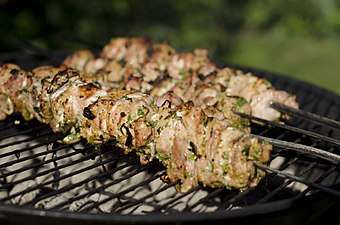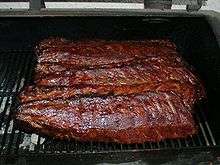Shashlik
Shashlik, or shashlyk, is a dish of skewered and grilled cubes of meat, similar to or synonymous with shish kebab. It is known traditionally, by various other names in the Caucasus and Central Asia,[2][3] and from the 19th century became popular as shashlik across much of the Russian Empire.[1][4][5]
 Shashlik cooked outdoors | |
| Course | Main course |
|---|---|
| Place of origin | Caucasus, Central Asia[1] |
| Serving temperature | Hot |
| Main ingredients | Meat, marinade, onions |
Etymology and history
The word shashlik or shashlick entered English from the Russian shashlyk, of Turkic origin.[6] In Turkic languages, the word shish means skewer, and shishlik is literally translated as "skewerable". The word was coined from the Crimean Tatar: "şış" ('spit') by the Zaporozhian Cossacks and entered Russian in the 18th century, from there spreading to English and other European languages.[2][3][7] Prior to that, the Russian name for meat cooked on a skewer was verchenoye, from vertel, 'spit'.[3] Shashlik did not reach Moscow until the late 19th century.[8] From then on, its popularity spread rapidly; by the 1910s it was a staple in St Petersburg restaurants and by the 1920s it was already a pervasive street food all over urban Russia.
Preparation

.jpg)
Shashlik was originally made of lamb, but nowadays it is also made of pork, beef, or venison, depending on local preferences and religious observances.[1][9] The skewers are either threaded with meat only, or with alternating pieces of meat, fat, and vegetables, such as bell pepper, onion, mushroom and tomato. In Iranian cuisine, meat for shashlik (as opposed to other forms of shish kebab) is usually in large chunks,[10][11] while elsewhere the form of medium-size meat cubes is maintained making it similar to brochette. The meat is marinated overnight in an acidic marinade such as vinegar, lemon juice, sparkling water, dry wine or other fruit/vegetable juices with the addition of onions, pepper, salt, herbs and spices.[12]
While it is not unusual to see shashlik today listed on the menu of restaurants, it is more commonly sold in many areas in the form of fast food by street vendors who roast the skewers on a mangal over wood, charcoal, or coal. It is also cooked in outdoor environments during social gatherings, similarly to barbecue in English-speaking countries.
See also
References
- Kraig, Bruce; Taylor Sen, Colleen (9 September 2013). Street Food around the World: An Encyclopedia of Food and Culture: An Encyclopedia of Food and Culture. ABC-CLIO. pp. 64, 294–295, 384–385. ISBN 9781598849554 – via Google Books.
An ancient dish, well known to herders and nomads across a wide swath of the Caucasus and Central Asia, shashlyk became popular in Russia in the mid-19th century after Georgia, Azerbaijan, and part of Armenia were absorbed into the Russian Empire. In those regions, shashlyk originally referred to cubes of grilled lamb cooked on skewers, whereas basturma was the grilled beef version of this dish. But Russians have broadened the term shashlyk to mean any kind of meat–pork, beef, lamb, venison–cut into cubes, marinated for several hours, threaded onto skewers, and cooked over hot coals.
- Pokhlebkin, William Vasilyevich (2004) [1978]. Natsionalnye kukhni nashikh narodov (Национальные кухни наших народов) [National Cuisines of Our Peoples] (in Russian). Moskva: Tsentrpoligraf. ISBN 5-9524-0718-8.
- Culture and Life. Union of Soviet Societies for Friendship and Cultural Relations with Foreign Countries. 1982 – via Google Books.
The Russian term, shashlik, has an interesting etymology: it would seem natural for the word to be borrowed from one of the Caucasian languages. But no, the Georgian for it is mtsvadi, the Azerbaijani, kebab, and the Armenian, horovts. Shashlik is a Zaporozhye Cossack coinage from the Crimean Tatar sheesh (spit), brought to Russia in the 18th century, after Field-Marshal Mienich's Crimean campaign. Prior to the 18th century, the dish was called verchenoye, from the Russian vertel, spit.
- Davidson, Alan (2014). Jaine, Tom (ed.). The Oxford Companion to Food. Oxford: Oxford University Press. p. 442. ISBN 9780191040726 – via Google Books.
- Albala, Ken (2011). Food Cultures of the World Encyclopedia. ABC-CLIO. pp. V3:51, V4:35, V4:304. ISBN 9780313376269 – via Google Books.
- American Heritage Dictionary Entry: shashlik
- "Vasmer's Etymological Dictionary". starling.rinet.ru. Archived from the original on 16 January 2008. Retrieved 10 May 2017.
- Владимир Гиляровский. Москва и москвичи, гл. Трактиры. 1926 (Vladimir Gilyarovsky. Moscow and Muscovites. 1926)
- Шашлык. In: В. В. Похлёбкин, Кулинарный словарь от А до Я. Москва, Центрполиграф, 2000, ISBN 5-227-00460-9 (William Pokhlyobkin, Culinary Dictionary. Moscow, Tsentrpoligraf, 2000; Russian)
- "Archived copy". Archived from the original on 2013-10-12. Retrieved 2013-10-12.CS1 maint: archived copy as title (link)
- "Archived copy". Archived from the original on 2013-10-12. Retrieved 2013-10-12.CS1 maint: archived copy as title (link)
- Marinade recipes for shashlik at RusslandJournal.de

